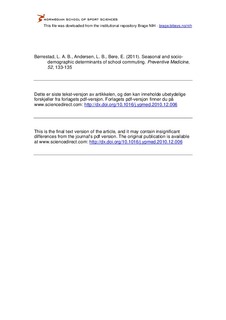| dc.contributor.author | Børrestad, Line Anita Bjørkelund | |
| dc.contributor.author | Andersen, Lars Bo | |
| dc.contributor.author | Bere, Elling | |
| dc.date.accessioned | 2011-06-10T07:49:37Z | |
| dc.date.available | 2011-06-10T07:49:37Z | |
| dc.date.issued | 2010-12-21 | |
| dc.identifier | Seksjon for idrettsmedisinske fag / Department of Sports Medicine | |
| dc.identifier.citation | Preventive Medicine. 2011, 52(2), 133-135 | en_US |
| dc.identifier.issn | 0091-7435 | |
| dc.identifier.uri | http://hdl.handle.net/11250/170829 | |
| dc.description | I Brage finner du siste tekst-versjon av artikkelen, og den kan inneholde ubetydelige forskjeller fra forlagets pdf-versjon. Forlagets pdf-versjon finner du på www.sciencedirect.com: http://dx.doi.org/10.1016/j.ypmed.2010.12.006 / In Brage you'll find the final text version of the article, and it may contain insignificant differences from the journal's pdf version. The original publication is available at www.sciencedirect.com: http://dx.doi.org/10.1016/j.ypmed.2010.12.006 | en_US |
| dc.description.abstract | Objective: To report prevalence of commuting to school in Norway with regard to season, gender, parental education level, ethnicity and distance to school.
Methods: Cross-sectional questionnaire data from the Fruits and Vegetables Make the Marks project collected in 2008, including 1339 ten to twelve-year-old children from 27 schools. The participants were categorized according to main mode of commuting to school in the three different school seasons (fall, winter and spring) and for the full school year if more than 50% of all trips were conducted by one specific mode.
Results: Most pupils (75%) were categorized as active commuters for the full school year. However, large seasonal variances were observed, especially for cycling. A total of 52%, 3% and 51% were categorized as cyclists in fall, winter and spring, respectively. Girls were more likely to be walkers (32% vs. 24%) and less likely to be cyclist (32% vs. 41%) than boys. Children of parents with higher education were more likely to be cyclist in fall (57% vs. 42%) and spring (56% vs. 40%), however, they were more likely to be walkers during winter time (71% vs. 56%).
Conclusions: Most children reported that they were active commuters. Large seasonal variation was observed, especially regarding cycling. | en_US |
| dc.language.iso | eng | en_US |
| dc.publisher | Elsevier | en_US |
| dc.subject | child | en_US |
| dc.subject | active commuting | en_US |
| dc.subject | cycling | en_US |
| dc.subject | walking | en_US |
| dc.subject | seasons | en_US |
| dc.subject | school | en_US |
| dc.title | Seasonal and socio-demographic determinants of school commuting | en_US |
| dc.type | Journal article | en_US |
| dc.type | Peer reviewed | en_US |
| dc.subject.nsi | VDP::Medical disciplines: 700 | en_US |
| dc.source.pagenumber | 133-135 | en_US |
